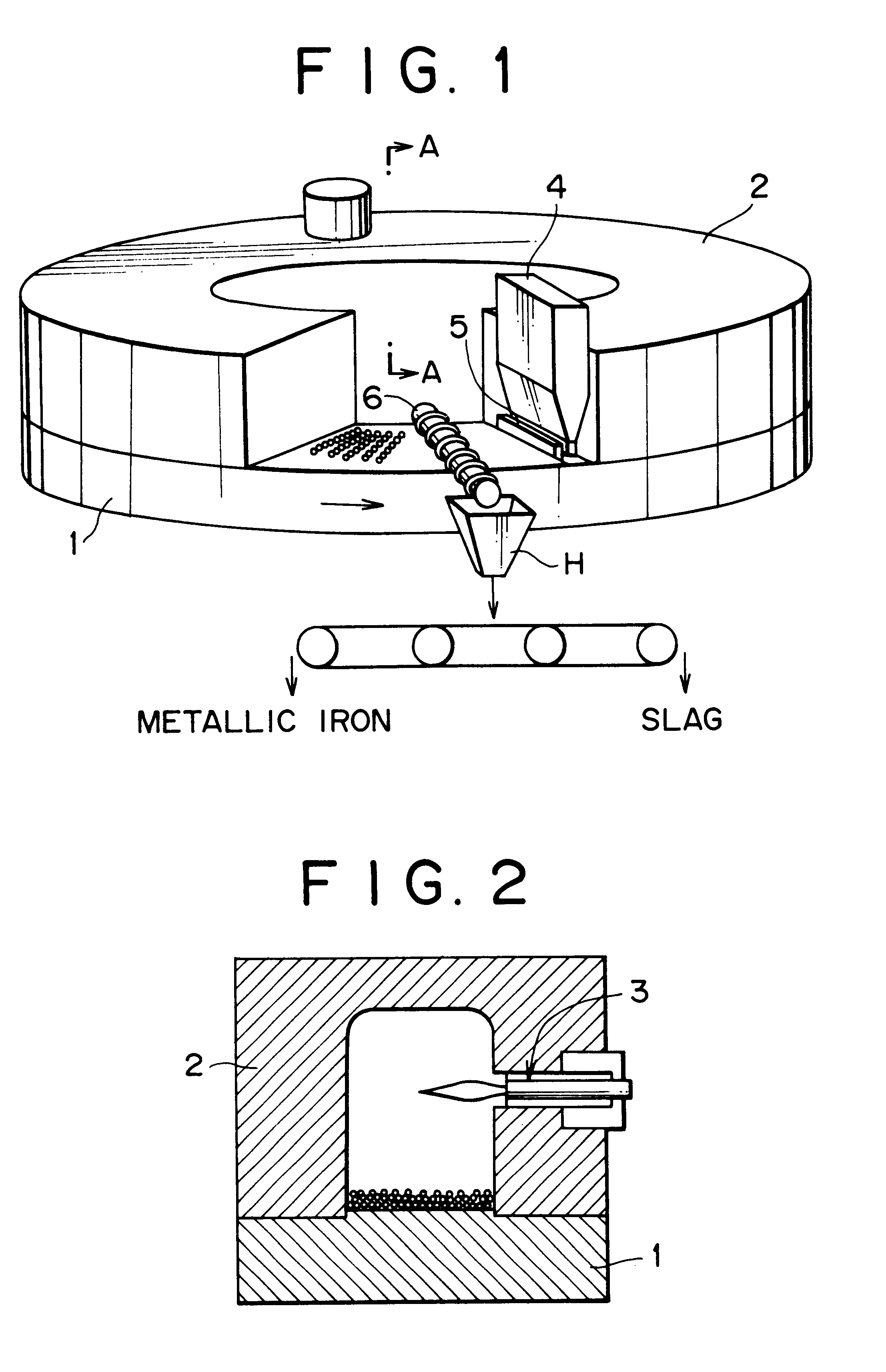However, while these publications disclose that metallic iron nuggets with high
Fe content can be obtained by making metallic iron nuggets while separating
slag collaterally produced in the reduction process, when the metallic iron produced by reduction is molten, it can not be said that reviews as to how to produce the metallic iron, with a high yield, as metallic iron nuggets having a grain size distribution which renders it easy to transport and
handle them has been made so sufficiently.
Furthermore, depending on the quality of raw material and mixture, sometimes it may not be possible to obtain metallic iron nuggets having an appropriate grain
diameter range as a product with a high yield, if the metallic iron nuggets contains
slag due to insufficient separation of the metallic iron from the collaterally produced slag and slack proceeding of coalescing or becomes so fine granulated product that its separation becomes difficult in the melting process after reduction.
However, it is difficult to say that the hitherto known techniques for producing metallic iron nuggets are established as concrete techniques for producing metallic iron nuggets having an appropriate grain diameter range with a high yield by taking quality, handling and the like as raw material for iron manufacture, steel-making and
alloy steel-making into collective consideration.
And, while it is desirable to use processed carbonaceous material such as coke and oil coke or good quality carbonaceous material such as smokeless
coal and
bituminous coal having a high
fixed carbon content ratio, as carbonaceous reducing agent used for the raw material in producing metallic iron nuggets as explained in the above, recently, it becomes frequent to inevitably use low quality
coal, such as
brown coal according to the depletion of good quality coal, and if low quality coal is used as carbonaceous reducing agent, the quality or the yield of metallic iron nuggets which is finally obtained will be reduced and more particularly, various unexpected problems will be arisen when it is intended to obtain metallic iron nuggets of an appropriate grain size distribution.
And, if the
atmospheric temperature is too high at the time of reducing (reduction period) in the above reducing and melting process, in particular, in certain period of reducing process, if the temperature becomes so high that it exceeds the
melting point of slag composition consisting of
gangue component, unreduced iron oxide and the like in the raw material, the slag of
low melting point will be molten and react with the
refractory material of the rotary
hearth, whereby melting trouble is caused in the
refractory material and thus the smooth
hearth can not be maintained.
Metallic iron is also produced by the
smelting reduction, and if the
smelting reduction is occurred, it becomes difficult to continuously operate using a practical use furnace because FeO containing slag with high fluidity cause eminent melting trouble in the
refractory material of
hearth.
Such a phenomenon is varied depending on composition of slag forming components and the like, which are contained in iron ore, carbonaceous material or binder of raw material; if the
atmospheric temperature at the time of reduction exceeds about 1400.degree. C., melting trouble is caused in the refractory material of hearth by bleeding the
low melting point slag as explained in the above, and if the temperature exceeds 1500.degree. C., the undesired
smelting reduction reaction is proceeded regardless of the type of raw material of iron ore and the melting trouble becomes eminent.
If the temperature of reduction period is too low, the reduction becomes difficult to be efficiently proceeded.
At this time, the molten metallic iron coalesces with each other and thus become coarse.
Furthermore, the case of low quality carbonaceous material having the
fixed carbon content less than 73% can be used without any trouble, if the above appropriate fixed carbon content can be totally secured by using high quality carbonaceous material having a high fixed carbon content ratio jointly, as a result, even it is low quality carbonaceous material which could have not been used alone can be effectively utilized.
However, from the latter half to the end of reduction period, the generation of CO gas is abruptly decreased, so that the self-
shielding effect will be decreased and the reduced metallic iron is likely to be re-oxidized because metallic iron is likely to be affected by combusted emission gas (oxidative gas such as CO.sub.2 and H.sub.2 O).
Furthermore, although the melting and the coalescing of fine metallic iron is proceeded because the
melting point is lowered due to the carburization of reduced iron by remaining carbon of raw material after completion of reduction, the self-
shielding effect will also be insufficient in the stage so that the metallic iron will be likely to be re-oxidized.
On the other hand, if the basicity adjustment by adding of CaO source is not performed, although there may be some differences depending the types of iron ore and the like, the basicity calculated from slag forming component included in raw material is not more than 0.3% in most case and it is unavoidable that
sulfur is admixed (vulcanizing) to metallic iron nuggets from slag having such a low basicity in the process of reduction or melting and coalescing process thereafter, so that about 85% of entire
sulfur contained in raw material is entered into metallic iron nuggets.
As a result, the
sulfur content in metallic iron nuggets becomes a very high value of 0.1-0.2% and deteriorates the quality as metallic iron nuggets.
 Login to View More
Login to View More 


